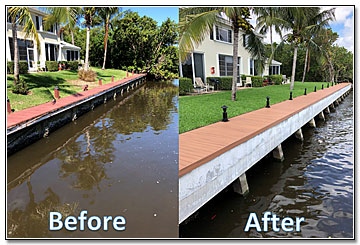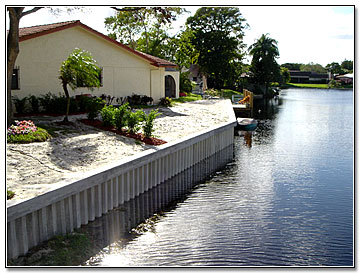 Miami
Florida Seawall Construction and Repair
Miami
Florida Seawall Construction and Repair
 Erosion, natural tidal occurrences (like King Tides), and even boat wakes pose a serious threat to any seawall and
easily separates the strong and well-maintained from the weak. Water runoff of just 3-6 inches from your roof, pool or a
sloping backyard after a typical South Florida rain can test your seawall to it’s limits.
Erosion, natural tidal occurrences (like King Tides), and even boat wakes pose a serious threat to any seawall and
easily separates the strong and well-maintained from the weak. Water runoff of just 3-6 inches from your roof, pool or a
sloping backyard after a typical South Florida rain can test your seawall to it’s limits.
Seawalls can be the single most expensive property repair that any waterfront homeowner may encounter—they cost more than
swimming pools and roofs. The investment you make periodically to perform routine maintenance and repairs can greatly increase
the longevity of your seawall and save you thousands of dollars in the long run.
Be vigilant and watch out for:
• Leaks
• Depressions appearing in the yard adjacent to the wall
• Soil disappearing
• Cracks in the cap of the wall face
Additionally, any dipping, sagging or bowing of your seawall could mean you have a serious issue that needs to be addressed immediately!
Sealing and patching is a common maintenance practice. All walls have sections between panels, which accumulate rocks, cracks, holes and are at
risk of loose joints over time. High strength marine grout will prevent sea water from flowing through the wall and eroding away fine sand and soil
from the yard and underneath the wall.
Another important repair is to the seawall footers. Footers are a necessary foundation to the overall strength of your seawall. Preventative measures
to reduce further eroding is repairing or re-installing a seawall footer. Often, the depth or penetration of the seawall no longer extends below the
“berm” or base of the canal bed. This is called “undermining” which is caused by either tidal erosion or upland pressure pushing sand fill out under
the bottom of the panel. A typical, less costly repair is to drive aluminum or vinyl sheet pilling in front of the existing wall to form a protective
barrier. When the barrier or “row” is driven in place, concrete is pumped to fill the area between the wall and the new footer sheets.
 Another, but more costly repair is installing batter pilings. Often, an old seawall will show signs of leaning outward by as much as a foot or more.
Causes are usually due to upland pressure brought on by pool construction or heavy loads like garden walls or big trees. To remediate this bowing,
a 12” x 12” concrete batter piling is driven in front of a seawall at a 30-degree angle and spaced every 10 feet.
Another, but more costly repair is installing batter pilings. Often, an old seawall will show signs of leaning outward by as much as a foot or more.
Causes are usually due to upland pressure brought on by pool construction or heavy loads like garden walls or big trees. To remediate this bowing,
a 12” x 12” concrete batter piling is driven in front of a seawall at a 30-degree angle and spaced every 10 feet.
When new batter pilings are installed, a new concrete cap can be formed and poured on top to connect the old wall to the new supporting batter pilings.
This results in preventing the seawall from total collapse and extending its useful life.
If you suspect that the integrity of your seawall has been
compromised in any way please reach out to us for a no cost estimate.


